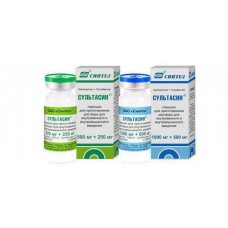Expiration date: 01/2025
Code ATX
J01CR01 (Ampicillin in combination with beta-lactamase inhibitors)
Active substance
ampicillin (in the form of sodium salt) (ampicillin), sulbactam (in the form of sodium salt) (sulbactam)
Form of issue, composition and packaging
Powder for preparation of solution for in/in and/m introduction white or white with a yellowish sheen color, hygroscopic.
1 FL.
ampicillin (in the form of sodium salt) 500 mg
sulbactam (in the form of sodium salt) 250 mg
Bottles of 10 ml (1) - packs cardboard.
Bottles of 10 ml (50) - cardboard boxes.
Powder for preparation of solution for in/in and/m introduction white or white with a yellowish sheen color, hygroscopic.
1 FL.
ampicillin (in the form of sodium salt) 1 g
sulbactam (in the form of sodium salt) 500 mg
Bottles of 10 ml (1) - packs cardboard.
Bottles of 10 ml (50) - cardboard boxes.
Clinical and pharmacological group
combination of penicillin with beta-lactamase inhibitor
Pharmaco-therapeutic group
Broad-spectrum penicillin group antibiotic with beta-lactamase inhibitor
Indications
Infectious and inflammatory diseases caused by microorganisms sensitive to the drug:
- respiratory infections (including pneumonia, chronic bronchitis);
- infections of ENT organs (including sinusitis, tonsillitis, otitis media, angina);
- infections of the urinary tract and genital organs (pyelonephritis, pyelitis, cystitis, urethritis, cervicitis, uncomplicated gonorrhoea);
- infections of the biliary tract (cholecystitis, cholangitis);
- infections of the gastrointestinal tract (peritonitis, abscess of the abdominal cavity);
- skin and soft tissue infections (erysipelas, impetigo, secondary infected dermatitis);
- bone and joint infections;
- sepsis;
- septic endocarditis;
- meningitis.
Prevention of postoperative complications during operations on the organs of abdominal cavity and small pelvis.
Dosage regimen
The drug is injected in/m or/in (drip quick 60-80 drops/min, jet - slowly, over 3-5 min). In / enter within 5-7 days, then, if necessary, continue the treatment move to/m introduction.
Below are the total doses of ampicillin and sulbactam (in a ratio of 2:1).
Adults with mild infection prescribed 1.5-3 g/day in 2 introduction; with moderate current - 3-6 g/day in 3-4 introduction; with severe current - 12 g / day in 4 introduction.
With uncomplicated gonorrhea-1.5 g/m once.
To prevent surgical infections-1.5-3 g/in during anesthesia; then within 24 hours after surgery-in the same dose every 6-8 hours.
Children drug is administered in a daily dose rate of 150 mg/kg of body weight (100 mg/kg of ampicillin and 50 mg/kg of sulbactam); frequency - 3-4 times/day.
In children from 1 month to 12 years (or body weight to 40 kg) in the treatment of severe infections dose increased to 300 mg/kg/day.
Newborns under 1 week of age and premature babies are prescribed the drug at a dose of 75 mg/kg (50 mg/kg of ampicillin and 25 mg/kg of sulbactam) / day every 12 hours.the Course of treatment - 5-14 days (if necessary, can be extended). After normalization of temperature and disappearance of other pathological symptoms, treatment continues for another 48 hours.
With impaired renal function and reduced creatinine clearance below 30 ml / min, it is advisable to increase the intervals between injections to 12-24 hours.
Rules of preparation of solution
The solution for parenteral use is prepared immediately before use.
For the/m introduction to the contents of the vial 0.75 g add 2 ml and vials of 1.5 g to 4 ml of water for injection or 0.5% solution of procaine (novocaine), or 0.9% solution of sodium chloride. For the/m introduction is possible dilution of 0.5% lidocaine.
For on / in a single dose dissolved in 0.9% sodium chloride solution or 5% dextrose solution (glucose) in the amount of 10 ml to 200 ml.
Side effect
From the digestive system: nausea, vomiting, diarrhea, decreased appetite, anorexia, increased activity of hepatic transaminases, pseudomembranous colitis.
From the nervous system: drowsiness, malaise, headache.
From the hematopoietic organs: anemia, leukopenia, thrombocytopenia.
Allergic reactions: urticaria, hyperemia of the skin, angioedema, rhinitis, conjunctivitis, fever, arthralgia, eosinophilia, anaphylactic shock.
Laboratory parameters: azotemia, elevated levels of urea, gipercreatininemia.
Local reactions: when the/m introduction - soreness at the injection site; at/V - phlebitis.
Other: long - term treatment-superinfection caused by drug-resistant microorganisms (candidiasis).
Contraindications to use
- infectious mononucleosis;
- lactation period (breastfeeding period);
- hypersensitivity.
With caution should appoint hepatic and / or renal insufficiency, pregnancy.
Special instruction
In patients with hypersensitivity to penicillins, cross allergic reactions with cephalosporin antibiotics are possible.
In the course of treatment, it is necessary to monitor the state of the functions of the hematopoietic organs, liver and kidneys.
Perhaps the development of superinfection due to the growth of insensitive to the drug microflora, which requires appropriate changes in antibacterial therapy.
In the treatment of septic patients may develop reactions bakterioliza (reaction Arisa-Herxheimer).
Influence on the ability to drive vehicles and management mechanisms
Data on the negative impact of the drug Sultasin® in the recommended doses on the ability to drive and control mechanisms are absent.
Overdose
Symptoms: manifestation of toxic effects on the Central nervous system (especially in patients with renal insufficiency); nausea, vomiting, diarrhea, violation of water-electrolyte balance (as a consequence of vomiting and diarrhea).
Treatment: symptomatic. It is excreted by hemodialysis.
Drug interaction
Bactericidal antibiotics (including cephalosporins, cycloserine, Vancouver, rifampicin), aminoglycosides have a synergistic effect; bacteriostatic antibiotics (including macrolides, chloramphenicol, lincosamides, tetracyclines) - antagonistic.
Increases the effectiveness of indirect anticoagulants (suppresses intestinal microflora, reduces the synthesis of vitamin K, increases prothrombin time).
Reduces the effectiveness of oral contraceptives, drugs, in the process of metabolism which is formed para-aminobenzoic acid and ethinyl estradiol (risk of bleeding "breakthrough").
Diuretics reduce the clearance of penicillins.
Allopurinol, phenylbutazone, NSAIDs, probenecid, reducing tubular secretion, increase the concentration of penicillin in plasma.
Allopurinol increases the risk of allergic reactions (skin rashes).
Pharmaceutical interaction
Sultasin ® is pharmacologically incompatible with antibiotics of the aminoglycoside group, with blood products or protein hydrolysates. In cases where Sultasin® and aminoglycosides are prescribed together, they should be administered in different parts of the body and with a time difference between injections of at least 1 hour.
Storage terms and conditions
The drug should be stored in a dry, protected from light, out of reach of children at a temperature not higher than 20°C. shelf life - 2 years.
Diseases
Meningococcal infection, Streptococcal septicaemia, other septicemia, Erysipelas, Gonococcal infection, Bacterial meningitis, not elsewhere classified, Purulent and unspecified otitis media, Acute and subacute endocarditis, Acute sinusitis, Acute tonsillitis, Bacterial pneumonia, not elsewhere classified, Acute bronchitis, Chronic sinusitis, Chronic tonsillitis, Chronic bronchitis, chronic tonsillitis unspecified, lung and mediastinum Abscess, Pyothorax (pleural empyema), Acute peritonitis (incl. abscess), Acute cholecystitis, Chronic cholecystitis, Cholangitis, Impetigo, skin Abscess, furuncle and carbuncle, Phlegmon, Pyoderma, Infectious dermatitis (infectious eczema), Pyogenic arthritis, Osteomyelitis, Acute tubulo-interstitial nephritis (acute pyelonephritis), Chronic tubulo-interstitial nephritis( chronic pyelonephritis, Cystitis) Urethritis and urethral syndrome, Inflammatory diseases of the prostate, Salpingitis and oophoritis, Inflammatory disease of the uterus, except the cervix (including endometritis, myometritis, metritis, pyometra, uterine abscess), Inflammatory disease of the cervix (including cervicitis, endocervicitis, ectocervical), Acute parametritis and pelvic cellulitis Other kind of preventive chemotherapy (the administration of antibiotics prophylactically)


